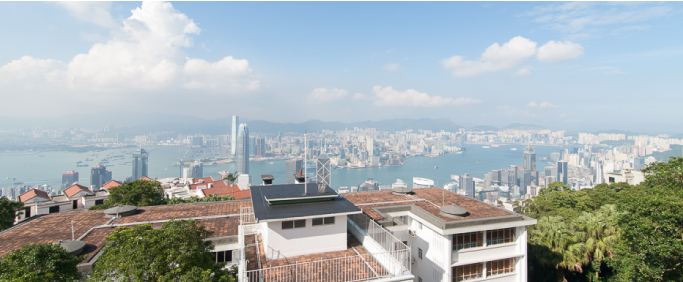Hong Kong lies 100 miles south of the Tropic of Cancer therefore it has a tropical monsoon climate.
The summer weather means heat, heavy rains and high humidity levels. The long summer period is generally considered from April to September. July, August and September being particularly hot and humid. Typhoons and tropical rains may be expected from May to November.
During October, November and December the weather is generally dry and sunny. Weather-wise it is the nicest time of the year with temperatures getting comfortably cooler by mid-October. The coldest months, January and February, temperatures average 59 degrees Fahrenheit but sometimes fall below 50 degrees.
| Month | Degrees °C | Humidity % | Sunshine Hrs | Rain Mn |
|---|---|---|---|---|
| January | 15.8 | 71 | 87.2 | 23.4 |
| February | 15.9 | 78 | 56.4 | 48.0 |
| March | 18.5 | 81 | 121.7 | 66.9 |
| April | 22.2 | 83 | 73.8 | 161.5 |
| May | 25.9 | 83 | 146.5 | 316.7 |
| June | 27.8 | 82 | 149.7 | 376.0 |
| July | 28.8 | 80 | 248 | 323.5 |
| August | 28.4 | 81 | 205.8 | 391.4 |
| September | 27.6 | 78 | 168.8 | 299.7 |
| October | 25.2 | 73 | 233.8 | 344.8 |
| November | 21.4 | 69 | 160.6 | 35.1 |
| December | 17.6 | 68 | 218.7 | 27.3 |

When it rains, it pours in Hong Kong. It rains so hard sometimes that your umbrella becomes a mere prop in the deluge. Your shoes are in for a beating: many people keep one special pair for those really rainy days. It’s just not worth ruining your good shoes—and you will, if you wear them out on a really rainy day.
Rain signals are not to be taken lightly; “Amber” “Red” and “Black” rainstorm signals are raised not necessarily in order. All those travelling should be aware of the signals, and the possibility that the signal may change during the course of the downfall.
Hong Kong Observatory (for weather information) Tel: +852 1878 200 www.hko.gov.hk
Amber
Amber signal is issued when heavy rain is expected, exceeding 30 millimeters an hour. Flooding might occur in poorly drained areas. Members of the public are advised to pay attention, the weather signal may be changed to Red or Black signals, during the downpour
Red
Red signal is issued when heavy rain is expected, exceeding 50 millimeters an hour. This can cause serious flooding. People who travel must seriously consider the weather and road conditions as well as the possibility of the signal changing.
Black
Black signal is issued when heavy rain is expected, exceeding 70 millimeters an hour. This can cause flooding and flash floods. People should take shelter. Schools and public transport will shut down until the danger has passed.
Tropical cyclones also known as a ‘typhoon’ normally occurs during the months May to November. In layman’s terms, typhoons are hurricanes. They are characterized by strong winds, rain and heavy seas. It is unusual for Hong Kong to experience a direct hit, but one or two typhoons a year comes close enough to cause heavy damage. The danger posed by “near miss” typhoons is flying debris - loose bamboo scaffolding can become flying spears in heavy wind - so please take the warnings seriously and stay indoors.
A typhoons progress can be monitored by:
- TV,a warning signal at the corner of the screen.
- Radio stations make frequent announcements
- All major buildings display signs at their entrances
- Check the Hong Kong Observatory website:www.weather.gov.hk
- Contact the Hong Kong Observatory Tel:1878 200
The most common tropical cyclone warning signal warnings are:T1,T3,and T8.
Typhoon Warning 1
Typhoon 1 is a stand-by signal, indicating that a tropical cyclone is positioned within 800km of Hong Kong; it is advisable to monitor the progress of the Typhoon signal for changes.
Typhoon Warning 3
Strong winds, with a sustained speed of 41- 62 km/h. Gusts may exceed 110km/h. Secure all loose objects, particularly on balconies and rooftops. Secure all temporary structures. Monitor the progress of the Typhoon signal for changes.
Typhoon Warning 8
Gale force winds expected with sustained speed of 41–62 km/h. Gusts may exceed 180 km/h. Complete all precautions before the gales commence. Lock all windows and doors, fit bars into positions and insert reinforced shutters and gates if available. Prevent large windowpanes from rattling and potentially shattering in the high winds, use adhesive tape or doorstoppers. Secure all outdoor temporary fittings and loose objects. Stay in a safe area away from windows. Ensure your car is parked in a safe place. Monitor the progress of the Typhoon signal for changes.
Typhoon Warning 10
Storms rarely reach this level of intensity. However, this signal is hoisted when hurricane force winds are making a direct approach to Hong Kong. Consequences of a direct hit are quite serious with broken power lines, major flooding, and flying debris. It is imperative that you stay indoors until the signal is lifted; a lull in the storm may only mean that the center is passing over with dangerous gusts to come in its wake.
To convert Fahrenheit to Centigrade: Subtract 32, multiply by 5 and divide by 9.
To convert Centigrade to Fahrenheit: Multiply by 9, divide by 5 and add 32.


